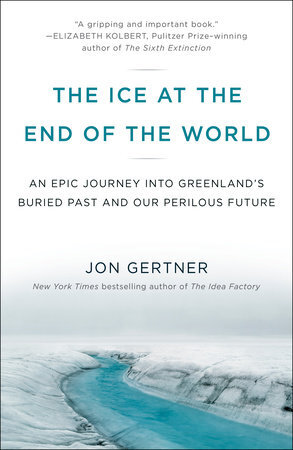The Ice at the End of the World by Jon Gertner
Penguin Random House $18.99
Reviewed by Serenity Schoonover
Jon Gertner’s book, The Ice at the End of the World, is aptly named. Starting off with a nail-biting history of early polar exploration, the book examines the significance Greenland’s melting ice sheet has on the earth’s present climate, and the forecast of its future.
Greenland is covered in a staggering 3 quadrillion ton ice sheet. In the 19th century, this icy landscape proved to be an idyllic training ground for explorers caught up in the world-wide obsession to discover the Poles. Ironically, many of these voyages turned into their own race for survival: “things often went wrong,” Gertner writes ruefully, “one might even say that in the Arctic, things always went wrong” (49).
Scientists followed in the explorer’s footsteps, and in the second half of the book, Gertner masterfully transforms decades of field research into an intriguing story. A glacier, he writes, is “about as complex as a system could get,” yet glaciologists discovered that a mammoth ice sheet is not a static wasteland, but rather serves as a highly sensitive gauge on global warming (262). And, through decades of studying ice samples taken from miles below the ice, glaciers are actually an artifact of the earth’s climate history, “a frozen archive of long-ago events” (177).
Gertner does not write as an alarmist, but his message is alarming, especially as scientists now estimate that Greenland’s ice sheet sieves off around 300 billion tons of water a year, which Gertner describes as “the white noise of a warming world” (xv). Ice melt of this magnitude could alter sea levels, a reality that motivated glaciologists to point to 2100 as the year in which developed countries, and China, need to radically reduce their carbon emissions, if there is to be any hope of lowering the earth’s temperatures, and stemming the ice melt (157).
The Ice at the End of the World deeply enriches our understanding of the role glaciers play in gauging the effects of global warming, but Gertner noticeably neglects pragmatic solutions. In practical terms, how can technologically dependent countries, like the U.S., reimagine its energy use to meet the 2100 deadline? And, in a worst-case scenario and sea levels do rise, what should countries with developed coastlines do to prepare? While Gertner presents a powerful and overall insightful narrative, the inattention he gives to these questions is as glaring as the sun hitting Greenland’s melting icefields.
Serenity Schoonover has an MA in History, is a fellow with the Arrowhead Regional Arts Council, and teaches writing classes to adults and teens. She was recently selected to teach at The Loft Literary Center in Minneapolis, MN. Her work has aired on National Public Radio and appeared in Women’s Independent Press, Cross-Country Skier, Bella Grace, CALYX, among others.

